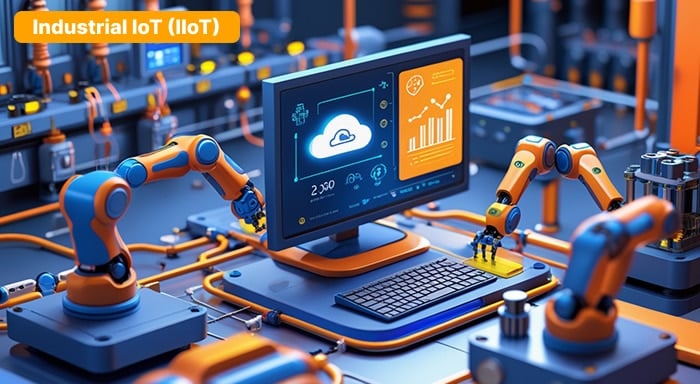The manufacturing industry has experienced a significant transformation in recent years. Modern factories use machines that interact with each other, analyze real-time data, and automate entire operations with minimal human intervention. This is no longer a futuristic concept---it’s the power of Industrial IoT (IIoT) happening right now. This is basically an interconnected system of physical objects, sensors, actuators, and networks, designed to streamline industrial processes.
It creates an automated system that collects, manages, and processes data across the network to get real-time insights of industrial operations. Unlike other IoT devices that focus on simplifying your daily lives, IIoT redefines how factories operate, making industrial processes faster, smarter, and more efficient. The goal of IIoT is to improve maintenance, boost efficiency, reduce system failures, and ultimately drive productivity and system security.
Let’s discuss everything about the Industrial Internet of Things (IIoT): definition, features, workings, and real-world applications. This comprehensive guide helps you better understand this technology, see its need across organization, and learn how it reshapes the future of manufacturing.
Understand Industrial IoT
IIoT, or Industrial Internet of Things, is one of the applications of IoT technology in an industrial context. It refers to the interconnected system of devices, software, and sensors in IoT to gather, process, and exchange data with each other. Typically, IIoT integrates with several other technologies like AI, ML, robotics, and cloud computing to optimize industrial operations. From asset tracking and intelligent machines to quality assurance and remote control in IoT, these are some examples of IIoT. It automates the entire process and enables predictive insights that save time, minimize human effort, and reduce cost. With real-time data analysis, businesses can gain data-driven insights that can foster business growth and informed decision-making. The interconnected sensors and actuators can store information that provides instant alerts of potential inconsistencies.
How Does Industrial IoT Work?
Think you are running a factory, and suddenly one of your machine's breakdowns. Traditionally, your maintenance teams need to stop everything and manually check the issue to fix it. That’s reactive maintenance. But industrial IoT works differently. It offers a network of smart devices and sensors that monitor unusual activities like high temperatures and abnormal vibrations. This predictive maintenance allows you to fix the issue before a system breakdown, saving both time and money. The collected data is transmitted from machines to central dashboards through cloud or edge computing. There, the data is converted to actionable insights that help determine how the machine operates. Whether you are an engineer, manufacturer, or manager, this data helps you make informed decisions, boost efficiency, and optimize productivity. Unlike conventional methods, this also reduces power consumption and minimises expensive downtime.
Benefits of IIoT
IIoT is more than just a tech trend – it's a game-changing solution that transforms manufacturing industry. Here’s why:
- Optimised Efficiency: IIoT helps businesses to boost productivity with greater efficiency by enabling automation and real-time tracking. These advanced technologies provide accurate diagnosis of damage components, allowing teams to focus on the necessary parts.
- Smart Decision Making: Real-time data analysis and data-driven insights help businesses make faster, accurate, and reliable decisions based on facts. Therefore, it is important for improving operational efficiency, productivity, and success of the business.
- Enhanced Customer Experience: AI-driven automation significantly improves quality, accelerates delivery time, and improves customer service. This is performed through various in-built features, such as real-time monitoring, data-driven insights, and predictive analytics.
- Ensure Safety: With automated responses and early detections of at-risk conditions, IIoT enhances the safety of workers from recurring strains and injuries. For industries like oil, gas, and mining, IoT devices monitor team, environmental conditions, and prevent potential dangers.
- Asser Monitoring: In the face of customer demands and the ever-evolving market, IIoT helps businesses and customers to monitor order status, location, and condition. With smart IoT devices, they get instant notifications about product health. This allows businesses to take preventive actions to offer better customer service.
- Save Time and Cost: With the use of smart sensors and actuators in IoT, it reduces machine failure and downtime. Businesses can automate repetitive tasks, lower unnecessary costs, and optimize power consumption. Therefore, it saves time, reduces human efforts, and eliminates expensive costs.
Real-World Applications of Industrial IoT
- Smart Manufacturing: Unlike traditional systems which rely on customer feedback, trends, and market changes, IIoT automates the process and eliminates human intervention. Smart machines can adjust their settings based on the product specifications, ultimately boosting productivity, efficiency, and growth of businesses.
- Healthcare: IIoT has made a remarkable impact in the healthcare industry by improving and streamlining patient care. The interconnected devices, sensors and network keep track of the patient's health and provide accurate diagnostics of potential diseases. This real-time data results in actionable insights into early prevention and effective treatment, delivering better and more effective patient care.
- Supply Chain: Connected sensors offer real-time updates on stock availability, shipping status, and instant alerts of discrepancies. This significantly lowers the error rate, accelerates delivery speed, and improves customer experience. The machines can also adapt to the changing requirements, providing businesses with a competitive edge.
- Remote Monitoring System: With real-time data visibility and valuable insights, IoT devices allow businesses to monitor machines from anywhere, at any time. Additionally, this enables them to manage, process, and control operations in remote and at-risk locations. Remote monitoring systems in IoT leverage sensors to gather data and detect errors before they hinder machine performance.
Challenges of Industrial IoT
Although no technology is perfect, despite its promising features and benefits, Industrial IoT also has some technical hurdles. Here are some common challenges:
- Cybersecurity Vulnerability: The interconnected nature of IoT devices can sometimes lack various security features, creating serious cybersecurity risks. Along with this, many IoT devices are built with fewer security considerations, making them susceptible to cyberattacks.
- High Investment: Building an IIoT device typically requires high initial investment costs, which can create a barrier for businesses with low budgets. These potential challenges can significantly impact a return on investment (ROI) and diminish long-term business growth.
- Legacy System Integration: Most companies still use legacy systems and equipment—often rely on analog computing systems. Integrating modern IoT into these systems comes with compatibility, retrofitting, and data silos challenges. These hurdles make the integration process a difficult, expensive, and time-consuming task.
With a strategic approach, businesses can implement IIoT today and leverage its features for long-term success. To stay ahead, organisations need to constantly monitor their systems and identify outdated components and forgotten updates, which require immediate attention. One of the common solutions to keep IoT infrastructure secure, efficient, and aligned with evolving business needs are proactive maintenance, regular assessment, and adopting advanced solutions.
Conclusion:
In today’s fast-paced world, running a successful business requires continuous monitoring and smart or efficient strategy. However, relying on traditional practices can be expensive, time-consuming, and more prone to human error. Implementing Industrial IoT offers a robust solution that reshapes industrial operations and simplifies their workflow. Additionally, this allows businesses to stay ahead of evolving demands by early detection, allowing them to take immediate preventive actions. Whether you are a manager, supplier, or tech-savvy, understanding IIoT, its benefits, challenges, and real-world use cases gives you a clear picture of industrial revolutions.
Also Read



